Aodelan Technology TGTE3T Wireless Flash Trigger Transmitter User Manual 20150126 E3 TX A1 ENx
Shenzhen Aodelan Technology Co., Ltd. Wireless Flash Trigger Transmitter 20150126 E3 TX A1 ENx
Users Manual
E3+ Wireless Trigger for Canon
Thank you for purchasing an Aodelan Product
Note: Before using the E3+ Wireless Trigger for Canon, please read this instruction
manual carefully, while also referring to the instruction manuals of your camera, flash
and other relevant devices.
Warnings
1. This product is a precise electronic instrument. Do not expose to damp
environments or dust.
2. Please shut down the power of all devices when installing the wireless trigger.
3. Do not drop or crush.
4. Do not use the wireless trigger at flammable, explosive or high temperature
environment.
5. Do not use harsh chemicals or solvents to clean the body. Use a soft cloth or lens
paper.
6. Remove batteries from the wireless trigger if not being used for an extended
period.
7. Interference: The E3+ wireless trigger transmits radio signals at 2.4GHz. Its
performance can be affected by electrical current, magnetic fields, radio signals,
wireless routers, cellular phones, and other electronic devices. Environmental
objects, such as large buildings or walls, trees, fences, or cars can also affect
transmission performance. If your wireless trigger can’t be triggered, move its
location slightly.
FCC Interference Statement:
This device complies with part 15 of the FCC Rules. Operation is subject to the
followingtwo conditions: (1) This device may not cause harmful interference, and (2)
this device must accept any interference received, including interference that may
cause undesired operation.
FCC Radiation Exposure Statement:
This equipment complies with FCC RF radiation exposure limits set forth for an
uncontrolled environment. This device and its antenna must not be co-located or
operating in conjunction with any other antenna or transmitter.
NOTE: This equipment has been tested and found to comply with the limits for a
Class B digital device, pursuant to Part 15 of the FCC Rules. These limits are
designed to provide reasonable protection against harmful interference in a
residential installation. This equipment generates, uses and can radiate radio
frequency energy and, if not installed and used in accordance with the instructions,
may cause harmful interference to radio communications. However, there is no
guarantee that interference will not occur in a particular installation. If this equipment
does cause harmful interference to radio or television reception, which can be
determined by turning the equipment off and on, the user is encouraged to try to
correct the interference by one or more of the following measures:
-- Reorient or relocate the receiving antenna.
-- Increase the separation between the equipment and receiver.
-- Connect the equipment into an outlet on a circuit different from that to which the
receiver is connected.
-- Consult the dealer or an experienced radio/TV technician for help.
E3+ Wireless Trigger for Canon/Transmitter
E3+ transmitter is a transmitter for wireless flash shooting. It can control up to 5
groups (15units) of Canon Speedlites that have a wireless multiple flash shooting
function using radio transmission, as well as non-wireless Canon ETTL Speedlites by
using E3+ receiver. The transmitter supports multiple flash modes and shooting
approaches including E-TTL II/E-TTL, Manual, MULTI, Ext.A and Linked Shooting,
catering to the diversification of photography lighting demands.
Table of Contents
I. Parts
II. Preparation Before Use
III. The LCD Display
IV. Wireless Flash Shooting: Radio Transmission
1. Wireless Flash Setting
2. ETTL: Fully Automatic Wireless Flash Shooting
3. Using Fully Automatic Wireless Flash
4. ETTL: Wireless Multiple Flash Shooting with Flash Ratio
5. M:Wireless Multiple Flash Shooting with Manual Flash Output
6. Multi:
7. Gr: Shooting with a Different Flash Mode for Each Group
8. Linked Shooting
V. Setting Transmitter Functions with Camera Operations
VI. Customizing the Transmitter
1.C.Fn: Setting Custom Functions
2.P.Fn: Setting Personal Functions
VII. Technical Specification
VII. Trouble Shooting Guide
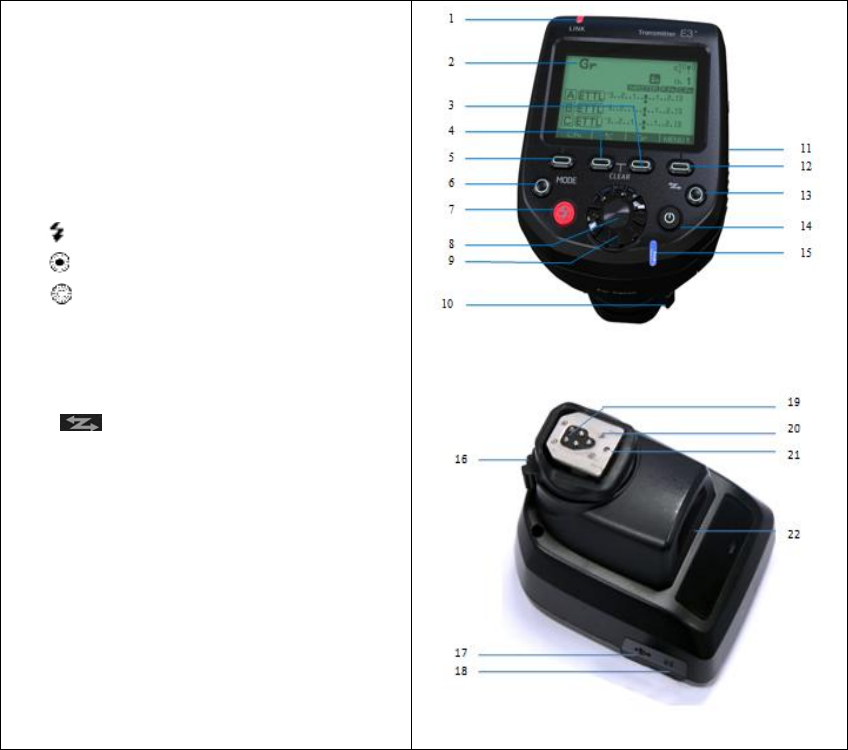
I.Parts
1.<LINK> indication light: Radio
transmission confirmation lamp
2.LCD panel
3.Function Button 3
4. Function Button 2
5. Function Button 1
6.<MODE>: Flash mode button
7.< >: Charge lamp/Test flash button;
8.< >: Select/Set button
9.< >: Select dial
10.Mounting foot lock lever
11.Battery compartment cover
12.Function button 4
13. < >: Linked shooting button
14.Power button
15.Flash exposure confirmation lamp
16.Lock-release button
17.USB port
18.Remote release terminal
19.Contacts
20.Mounting foot
21.Locking pin
22.AF assist light
II. Preparation before use
Installing the batteries
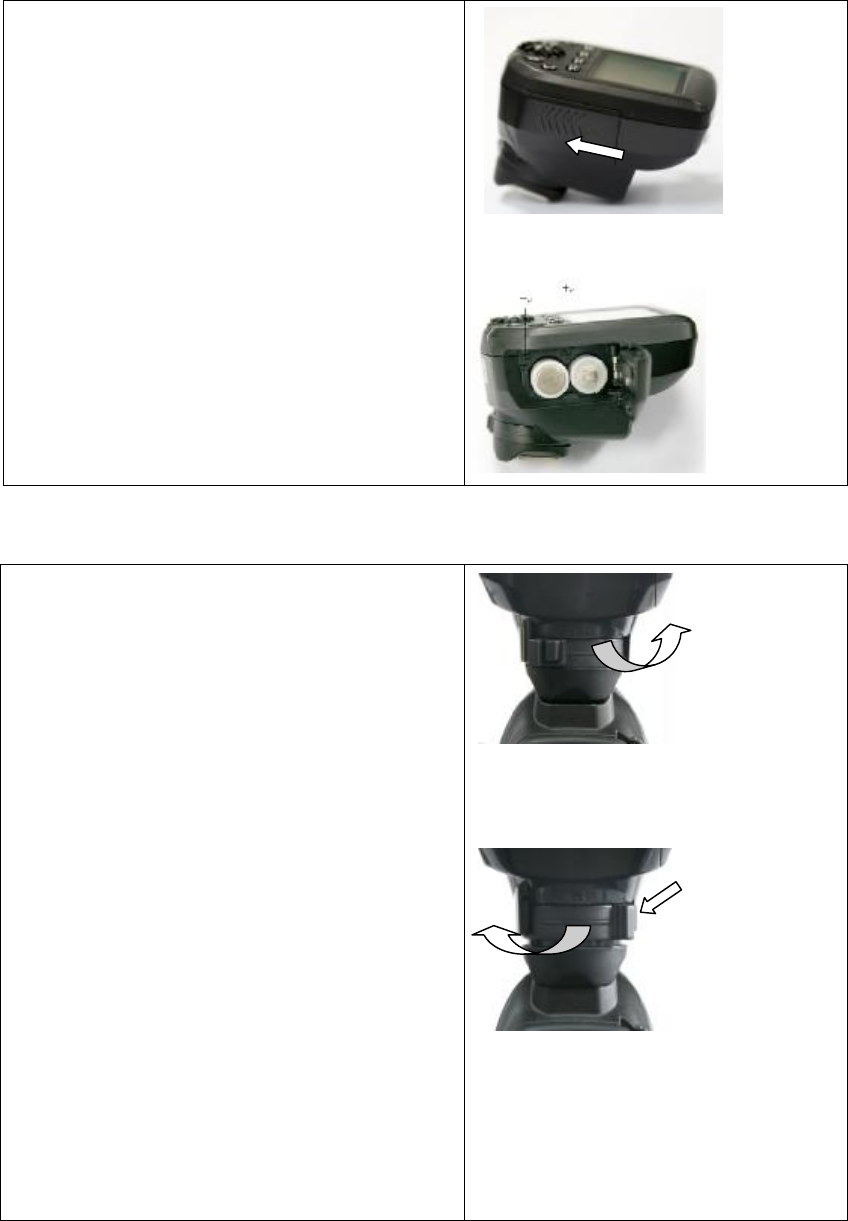
1. Press the battery compartment cover and
slide it down as shown to open the battery
cover. (Picture 1)
2. Insert the batteries as shown. Make sure
the “+” and“-”battery contacts are
correctly oriented as shown. (Note:
Please use 2 pieces of AA alkaline
batteries or AA type NI-MH batteries.
(Picture 2)
3. Replace the battery cover and push back
into the locked position.
Attaching and Detaching the E3+ transmitter
Attaching the E3+ transmitter to the camera
hot shoe
1. Turn off the camera and E3+
transmitter
2. Align the E3+ transmitter hot shoe
with camera’s hot shoe mount.
3. Slide the E3+ transmitter all the way
into the camera’s hot shoe mount.
4. Lock the E3+ transmitter by sliding
the mounting foot lock lever to the
right until the lock lever clicks in
place.(See picture 3)
Detaching the E3+ Transmitter
1. Lock release: press the lock-release
button while slide the lock lever all the
way back to the left.(see picture 4)
2. Slide the E3+ transmitter out of camera’s
hot shoe mount.
Turn On/Off the E3+ transmitter
1. Turn On: Press and hold the power button until MENU interface is displayed on
screen.
2. Turn off: Press and hold the power button until the LCD screen goes blank.
1
2

Note: When is displayed, please replace the batteries with new ones.
USB port
The firmware of E3+ transmitter can be upgraded via the USB port, so as to adjust its
parameter and extend its compatibility with cameras to come in the future.
1.1 Connect the USB cable to the computer and the other end of the USB cable to
E3+ transmitter’s USB port. A mobile device icon will be displayed on the computer
when successfully connected.
1.2 Double click to start the upgrade software. The upgrade software can be used to
check version info, and upgrade the Base software, RF software and Icon.
Click "Version" icon, the current version information of the connected E3+ transmitter
will be displayed in the software window.
Click "Base software" icon, locate and double click on the FDS file from the pop-out
window. Then it starts loading the new firmware.
Click "RF software" icon, locate and double click on the RFC file from the pop-out
window. Then it starts loading the new firmware.
Click "Icon" icon, locate and double click on the FIF file from the pop-out window.
Then it starts loading the new firmware.
1.3 The status of the upgrade will be displayed in the process bar. When completed,
an “Updata OK”will be displayed at the bottom of the upgrade software window, and
a “Download OK” will be displayed on the transmitter’s LCD screen. Upon
completion, disconnect the USB cable and restart the E3+ transmitter.
Note:
Please ensure stable power supply when attempting to upgrade the E3+ transmitter..
Loss of computer power during the upgrade process could fail the upgrading.
Check Version info on E3+ transmitter
You can check the present version information on E3+ transmitter: while pressing the
power button to turn on the transmitter, press the flash <MODE> button simultaneously
until the version info is displayed on the LCD screen.
<>: Charge Lamp/Test Flash Button
1. The charge lamp lights when the wireless shooting (slave) is ready.
2. During wireless shooting, master unit’s charge up will be lit when all slave units
are fully charged.
3. During wireless shooting, you can press the transmitter’s charge lamp (test flash
button to fire a test flash.
Remote Release from Slave Unit
When performing wireless shooting, E3+ transmitter supports remote release (remote
control shooting) from a flash set or E3+ receiver as a slave unit. For operations, see
the flash or E3+ receiver’s instruction manual.
Note
When using the remote release function, the slave unit camera might need a shutter
release cable(available separately) depending on the camera models.
1) EOS digital cameras since 2012 do not need to use shutter release cable.
2) EOS cameras before 2012, which are compatible with E-TTL II/E-TTL autoflash
and come with N3 type remote terminal EOS, shutter release cable will be needed
for linked shooting.
Test Flash from a slave unit
You can fire a test flash from a flash set as a slave unit. For operations, see the flash’s
instruction manual.
Note: When two or more units are set to master, the unit with the <LINK> lamp lit in
green is the one that fires.
Modeling Flash
1. Modeling Flash from a Master Unit
When the camera’s dept-of-view preview button is pressed, the flash will fire
continuously for 1 sec. This is called the modeling flash. It enables you to see the
shadow effects of the flash on the subject and the lighting balance. Besides, you can
also fire the modeling flash by pressing the charge lamp/test flash button on E3+
transmitter (the operation required to be enabled in advance by setting C.Fn 02).
2. Modeling Flash from a Slave Unit
With EOS digital cameras released since 2012, you can fire the modeling flash from a
flash set as a slave unit. For the operations, see the flash’s instruction manual.
AF assist light
In low light/contrast situation, the E3+ transmitter’s built-in Auto Focus Assist Light
will illuminate to assist with AF. The AF Assist Light on the front of the transmitter
will project a focusing target on the subject. As laser light, the AF assist light has the
advantages of better directionality, less decay and better assist performance compared
with LED type AF assist light. You can choose to enable or disable the AF assist light
by setting P. Fn 08.
Note: The laser AF assist light is safe with optical power less than 5mW. However,
please still avoid pointing the light at human eyes.
Memory Function
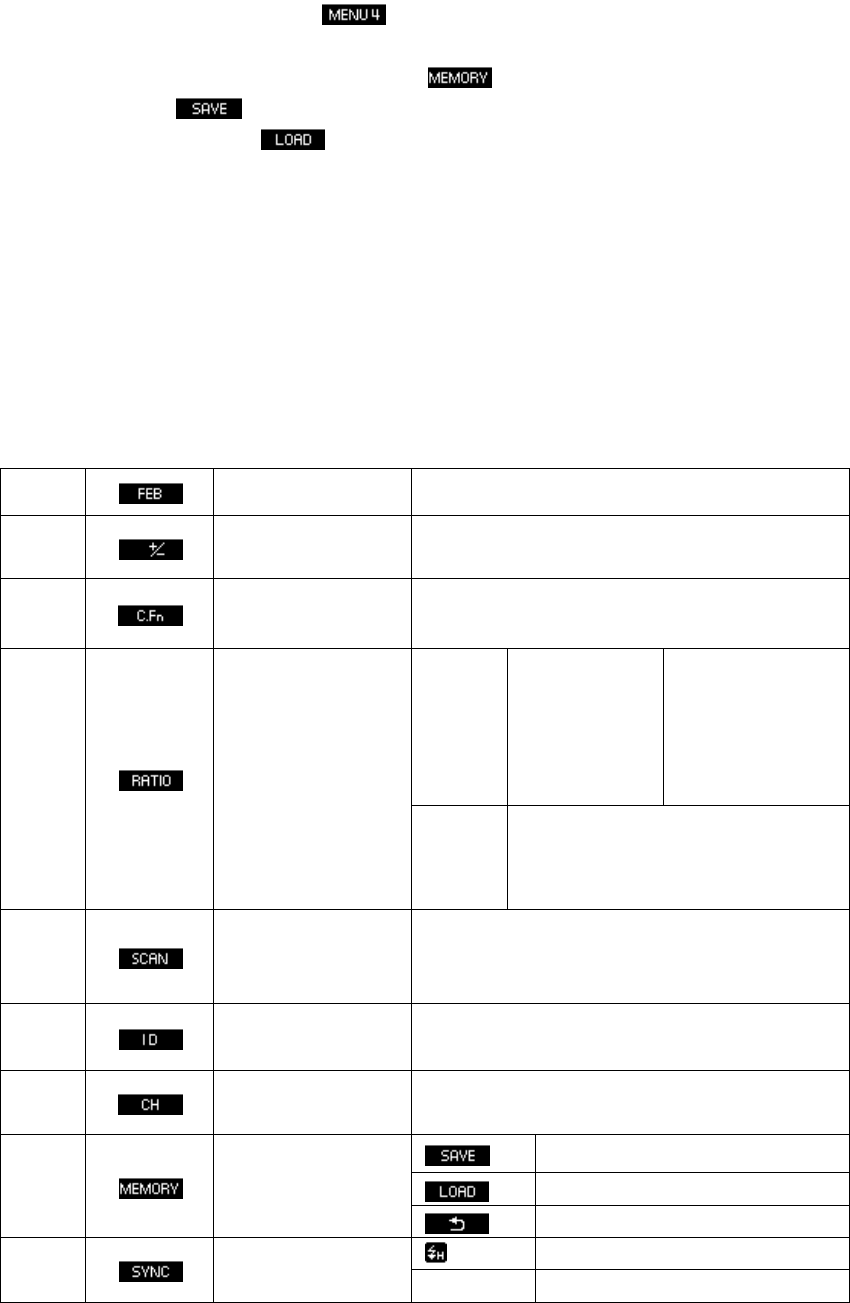
E3+ transmitter supports memory function. You can save the wireless settings and
recall the setting later.
1. Press function button 4 until is displayed.
2. Save or load the settings
Press function button 3 corresponding to , and then press function button 1
corresponding to , the settings are saved (stored in the memory). Press function
button 2 corresponding to , the settings that were saved are set.
Clearing Transmitter Settings
You can return the settings for wireless shooting to their default settings.
Press function button 2 and 3 simultaneously for 2 seconds or longer, the transmitter
setting are cleared and the shooting mode returns to <ETTL>flash mode. Note that
even when the settings are cleared, the transmission channel, the wireless radio ID
and the C.Fn and P.Fn settings are not canceled.
III. MENU Functions
1. FEB level ±3EV(in 1/3-stop increments)
2. Flash exposure
compensation ±3EV(in 1/3-stop increments)
3. C.Fn function C.Fn -01 to 22
4. Flash Ratio
ETTL
RATIO A:B C
RATIO A:B
RATIO OFF
A:B ratio
setting:
8:1 to 1:8, in
1/2-stop
increments
M/Multi
RATIO A:B:C
RATIO A:B
RATIO OFF
5. Scan function
Scan the radio reception status and set the
master unit’s transmission channel
automatically or manually.
6. Wireless radio ID 0000-9999
7. Transmission
Channel Ch.1-Ch.15and Auto
8. Memory Function
Save the present setting
Load the settings that were saved
Back to shooting-ready state
9. Sync Mode
Enable High Speed Sync
No display First Curtain Sync
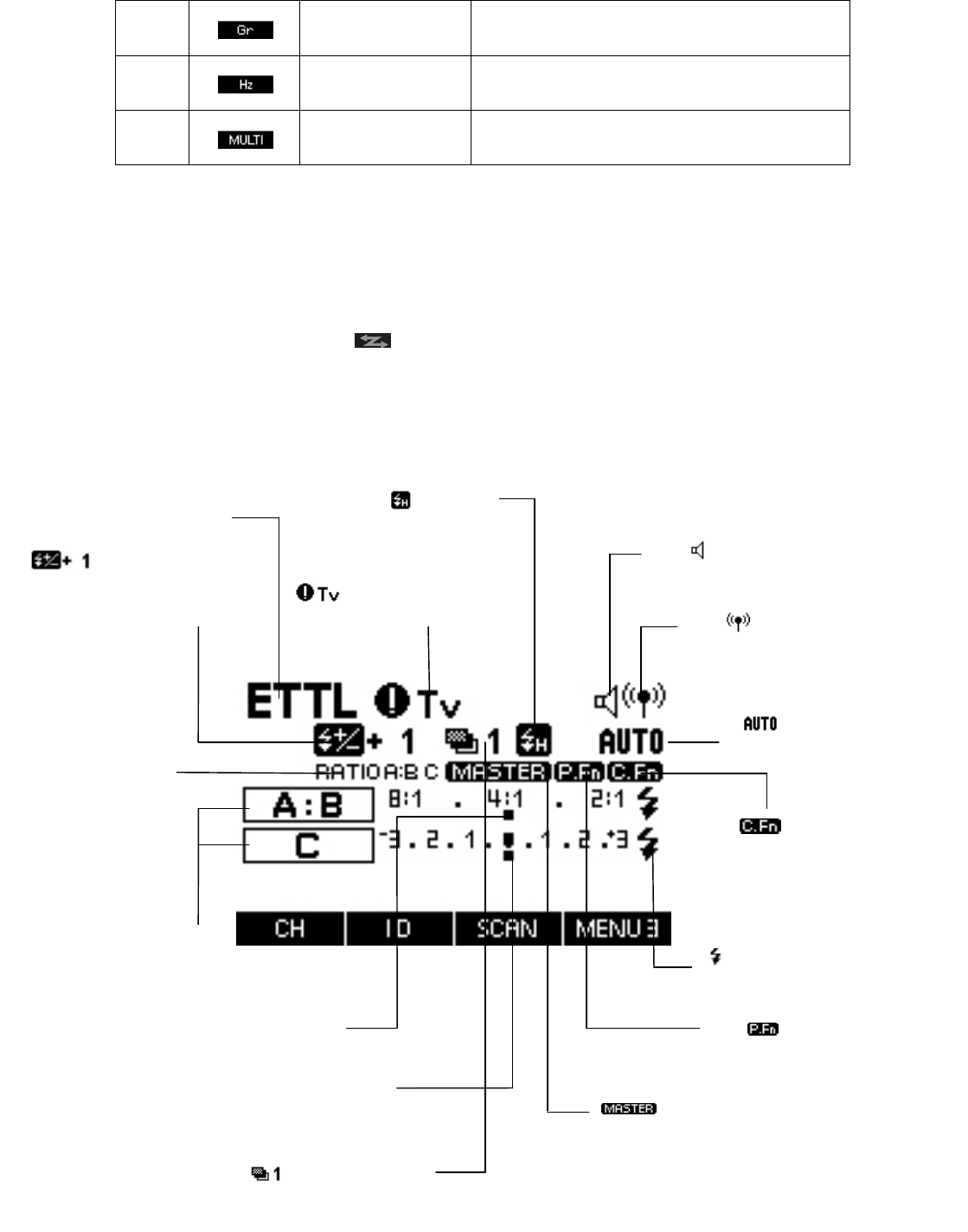
10 Firing group Up to 5 firing groups A、B、C、D、E(at Gr
mode)
11 Multi Stroboscopic
Flash Frequency 1-500Hz
12. Multi Stroboscopic
Flash Number 1-100times, based on the frequency and flash
output
LCD Display
E3+ transmitter’s LCD display comes with five modes: ETTL、M、MULTI、Gr and
LINKED SHOT. You can cycle through “ETTL、M、MULTI、Gr” by pressing <MODE> button.
And by pressing and holding < >button, you can switch the LCD to display LINKED SHOT.
Different display settings come to perform different flash modes. Find details about the five flash
modes as following
1. ETTL/ETTL II autoflash
Ch: Channel;
AUTO: Channel Automatic setting
: Master
: Radio transmission
wireless shooting
: Sync speed warning
: Beep
: High
Speed Sync;
: Custom Functions
: Slave flash ready
: Flash Exposure
Compensation and Flash
Exposure Compensation amount
Personal Functions
RATIO
:
RATIO OFF
,
RATIO A:B
,
RATIO A:B
C
Firing Group
Flash ratio
Flash exposure level
: FEB and FEB
sequence
E-TTLⅡ/E-TTL autoflash
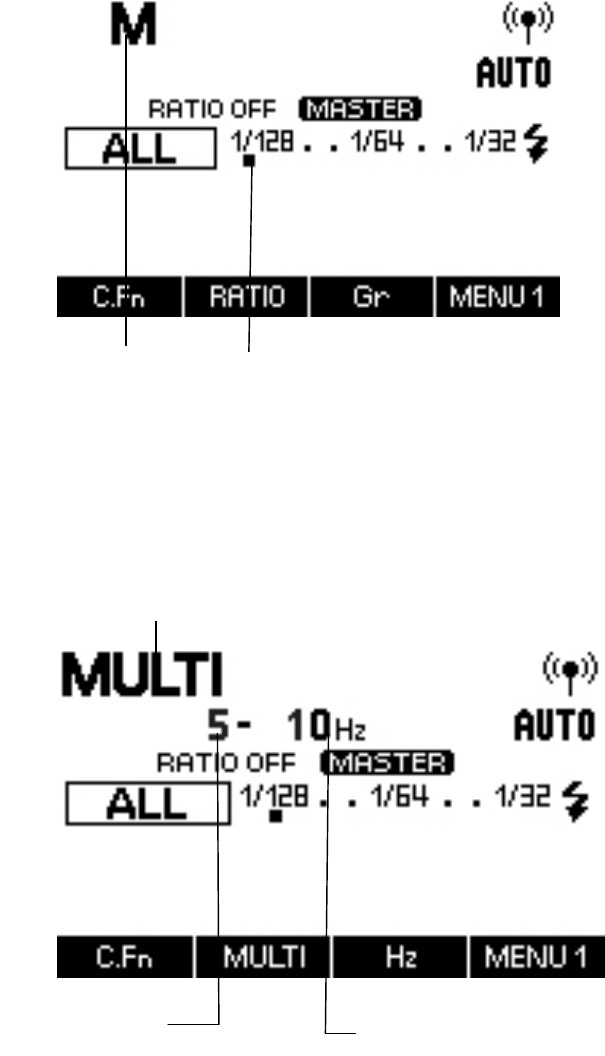
2. Manual Flash
3. Stroboscopic Flash
4. Group Firing
Manual Flash Output
M: Manual Flash
Number of flashes Flash frequency
MULTI: Multi (Stroboscopic) flash
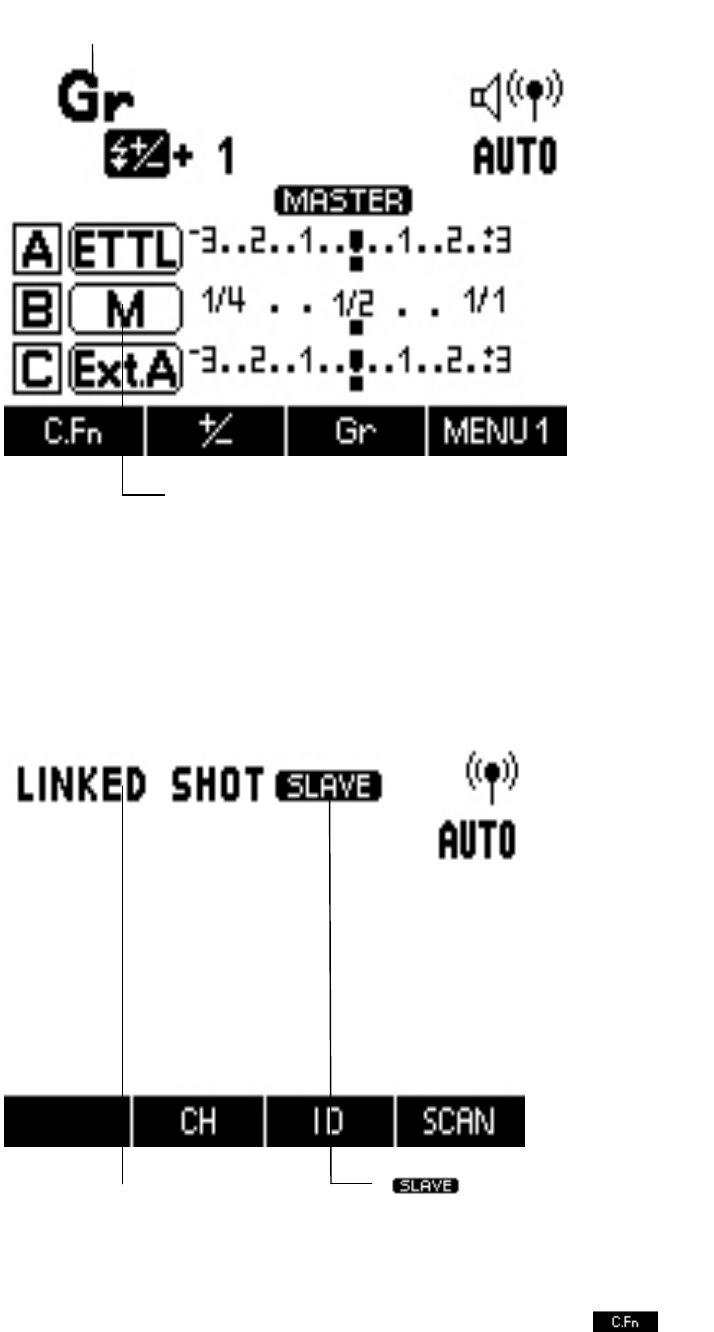
5. Linked Shooting
Note: 1) The display will show only the settings currently applied.
2) The functions displayed above function buttons 1 to 4, such as and
Three flash modes optional:
ETTL、M、Ext.A
Gr: Firing Group
:SLAVE, Slave unit;
MASTER, Master unit;
LINKED SHOT: Linked
Shooting

, change according to the settings’ status.
3) When a button or dial is operated, the LCD panel illuminates.
IV. Wireless Flash Shooting: Radio Transmission
Note:
The transmitter attached to the camera is called the master unit, and a flash that is
wirelessly controlled is called the slave unit.
When the camera’s shooting mode is set to fully automatic mode or an Image Zone
mode, the operations below are not available. Please set the camera’s shooting mode
to P/Tv/Av/M/B(Creative Zone mode).
Wireless Flash Shooting
Using a transmitter and Canon Speedlites compatible with radio transmission wireless
shooting makes it easy to shoot with advanced wireless multiple flash lighting, in the
same way as normal E-TTLⅡ/E-TTL auto flash shooting.
The settings of the transmitter attached to the camera (master) are automatically
reflected on the flash that is wirelessly controlled (slave). Therefore, you do not need
to operate the slave unit while shooting. You can then perform wireless E-TTL
II/ETTL autoflash shooting just by setting the master unit to ETTL mode.
You can choose to perform autoflash shooting using one slave unit only, or perform
wireless multiple flash shooting using two or more(up to 15) slave units.
The slave units can be speedlites that is compatible with radio transmission wireless
shooting and set on slave mode, and also, by using with E3+ receiver, other Canon
ETTL flashes that are incompatible with the radio transmission wireless function.
Master Unit Slave Unit
E3+Transmitter
Canon Speedlites that have a wireless flash shooting function
using radio transmission, like 600EX-RT (Slave mode).
E3
+
receiver+Canon ETTL Flash(Non-wireless mode)
Note:
1) When using E3+receiver as slave unit, restrictions will apply to parts of its
functions. And parts of the operations would also be different. For details, see the
instruction manual of E3+receiver
2) When performing radio transmission wireless flash shooting, restrictions may
apply to the flash mode, maximum flash sync speed (referred to below as the “flash
sync speed”) and high-speed sync function, depending on the camera that you use.
Wireless Settings
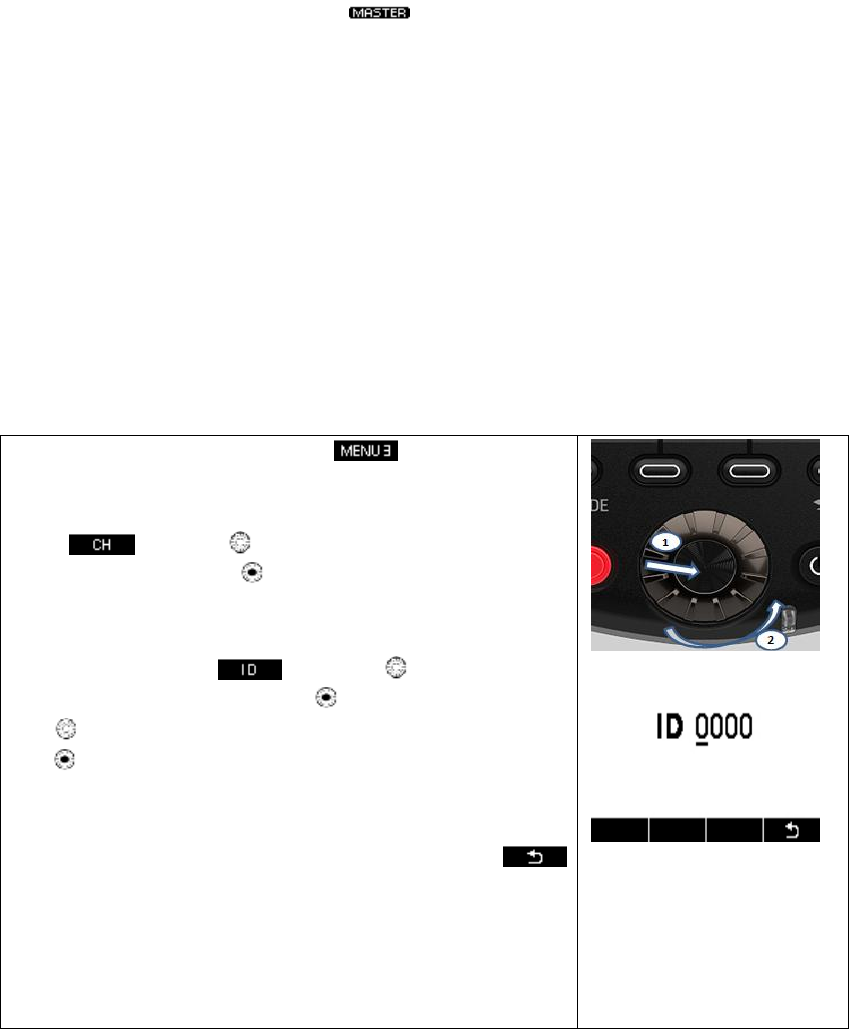
To perform wireless shooting, set the E3+ transmitter(master unit)and flash(slave unit)
with the following procedure.
1. Master unit setting: Check that is displayed.
2. Slave unit setting: For the slave unit setting, see the flash or receiver’s instruction
manual.
3. Transmission Channel/Wireless Radio ID Settings: To avoid interference with
wireless multiple flash systems using radio transmission that are used by other
photographers or with other devices that use radio waves (wireless), you can change
the transmission channel and wireless radio ID.
Use the following procedures to set the master unit’s transmission channel and
wireless radio ID. Set the same channel and ID for both the master unit and slave unit.
For the slave unit settings, see the flash’s instruction manual.
1. Press function button 4 until is displayed.
2. Set a channel: press function button 1 corresponding
to , turn < > to select from Ch. 1-15 or
Auto, and press < > button to finish the setting.
3. Set wireless radio ID: press function button 2
corresponding to , turn < > to select the
digit to be set and press < > button. Again turn <
> to select a number from 0-9, and press the <
> button.
4. Repeat step 4 to set the four ID digits one by one.
Press function button 4 for corresponding to
to return to the shooting-ready state.
5. When the transmission between the master unit and
slave unit is established, the <LINK> lamp lights
green.
4. Scanning the Master Unit Transmission Channels to Set
E3+ transmitter is able to scan the radio reception status and set the master unit’s
transmission channel automatically or manually. When the channel is set to “AUTO”,
the channel with the best reception signal is automatically set. When setting the
channel manually, you can set the transmission channel again while referring to the
scan results.
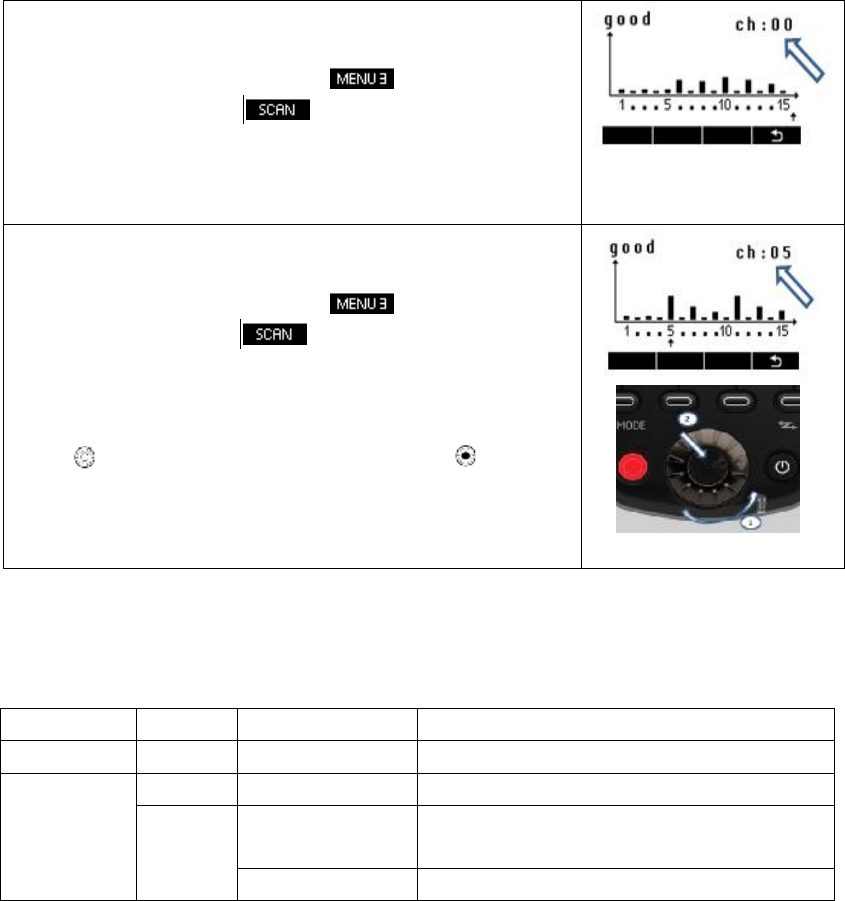
1. Scanning while “AUTO” is set:
Press function button 4 to display , and then function
button 3 corresponding to . The channel is reset to one
with a good reception signal.
2. Scanning while Ch.1 to 15 is set:
Press function button 4 to display , and then function
button 3 corresponding to . The radio reception status is
displayed in a graph. The higher the peak of the channel in the
graph, the better the radio reception signal.
Turn< >to select from Ch.1 to 15, and press< >button to
return to shooting-ready state.
The color of <LINK>lamp changes depending on the transmission status of the master unit and
the slave unit.
Note: 1).If the transmission channels of the master unit and slave unit are different, the slave unit
does not fire. Set both to the same number, or set both to “AUTO”.
2).If the wireless radio IDs of the master unit and slave unit are different, the slave unit
does not fire.
ETTL: Fully Automatic Wireless Flash Shooting
E3+ transmitter attached to the camera (master) and a wirelessly controlled flash
(slave) can perform fully automatic wireless shooting.
1. Autoflash Shooting Using One Slave Unit
Color Status Description Action
Green Lit Transmission OK -
Red
Lit No connected Check the channel and ID
Blinking
Too many units
Master Units + slave units = 16units
or less
Error Turn the power off and on again

1.1 Set the flash as the slave unit: For the slave unit setting, see the flash or the
E3+receiver’s instruction manual. Set A, B or C as the firing group. If set to D or E,
the flash does not fire.
1.2 Check the channel and ID: If the channels and IDs of the master unit and slave
unit are different, set them to exactly the same number.
1.3 Position the camera and the slave unit within the range of wireless radio
transmission.
1.4 Set the flash mode to <ETTL>: Press the <MODE> button on master and set the
flash mode to <ETTL>.The slave unit is set automatically to<ETTL> during shooting
via the control form the master unit. For slave units that use E3+ receiver, flashes on
the receiver need not to set to wireless slave mode, but the need to be set to ETTL
mode manually during shooting.
1.5 Check the transmission status and that the flash is ready:
Check that the <LINK>lamp lights green;
When the flash that is set to wireless slave mode is ready, the AF-assist beam emitter
blinks at 1-second intervals;
Check that the < > slave flash-ready icon is lit on the master unit’s LCD panel;
When the recycling of all the flash units is completed, the master units’ charge lamp
lights on.
1.6 Check the operation: Press the master unit’s test flash button (charge lamp). The
slave unit flash will fire. If no, check that it is placed within the operation range.
1.7 Take the picture: Set the camera and take the picture, in the same way as with
normal flash shooting. If a standard flash exposure was obtained, the flash exposure
confirmation lamp lights up (blue) for 2 sec.
2. Autoflash Shooting Using Multiple Slave Unit
When you need more flash output or you want to perform lighting more easily, you
can increase the number of slave units and fire them as a single flash. To add slave
units, use the same procedure as “ Autoflash Shooting Using One Slave Unit”. Set A,
B or C as the firing group. The flash will not fire if it is set to D or E. When the
number of the slave units is increased, automatic control is performed to fire all
flashes at the same flash output and ensure that the total flash output results in
standard exposure.
Using Fully Automatic Wireless Flash
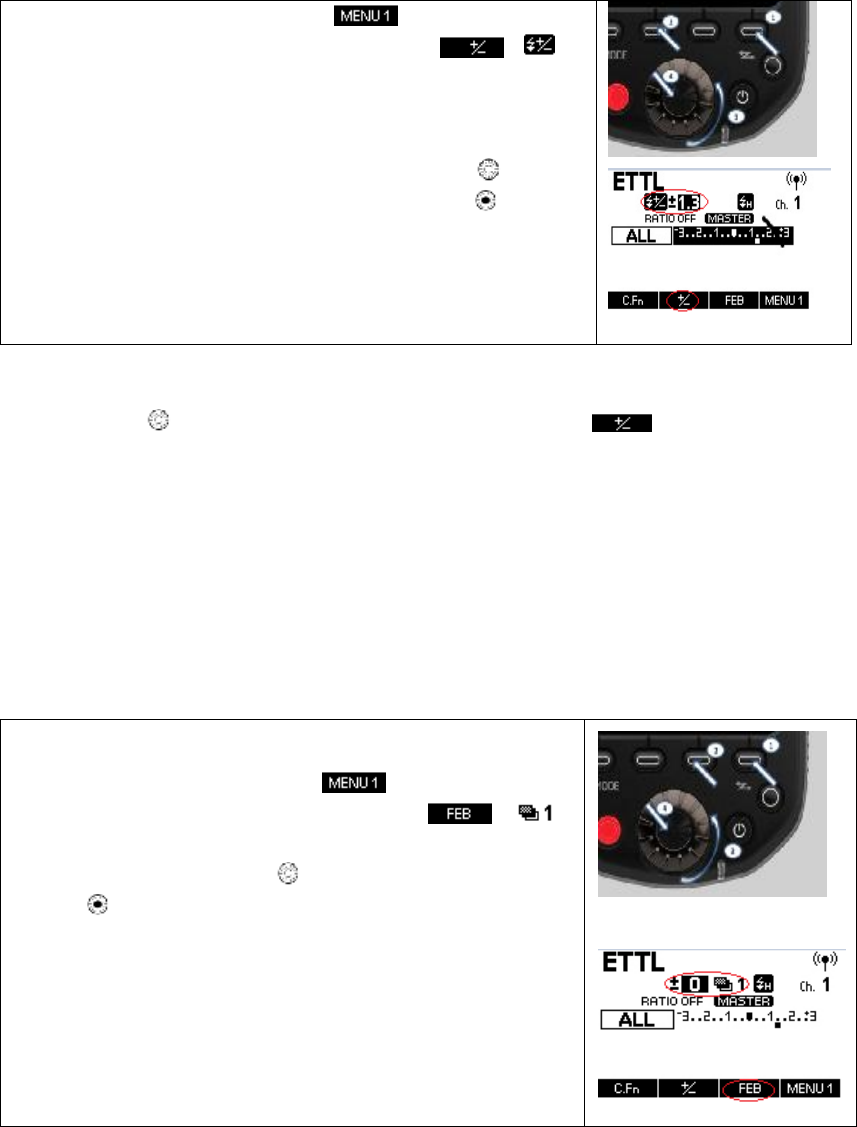
Flash exposure compensation and other settings set on the E3+ transmitter (master unit)
will be automatically set in the flash (slave). You don’t need to operate the slave unit.
1. Flash Exposure Compensation
In the same way as normal exposure compensation, you can set exposure
compensation for flash. The flash exposure compensation amount can be set up to ±3
stops in 1/3-stop increments.
1. Press function button 4 until is displayed.
2. Press function button 2 corresponding to , is
displayed and flash compensation amount is
highlighted.
3. Set the flash compensation amount: turn< > to set
the flash compensation amount, and press < >button.
4. ”0.3” indicates 1/3 stops, and”0.7”indicates 2/3 stops
5. To cancel flash exposure compensation, return the
compensation amount to “±0”.
Note:
1. By setting C.Fn13, you can choose to set the flash compensation amount by
turning < > only, without operating function button 2 .
2. If the camera’s exposure compensation is set to 1/2-stop increments, flash
exposure compensation will be up to ±stops in 1/2-stop increments.
2.FEB
With FEB (Flash Exposure Bracketing) function, you can take three shots while
automatically changing the flash output. The settable range is up to ±3 stops in 1/3-stop
increments.
1. Press function button 4 until is displayed.
2. Press function button 3 corresponding to ,
is displayed and the FEB level display is highlighted.
3. Set the FEB level: turn< > to set FEB level and
press < > button.
4.”0.3”indicates 1/3 stops, and”0.7”indicates 2/3 stops.
5. When used together with flash exposure, FEB shooting
is performed based on the flash exposure compensation
amount.
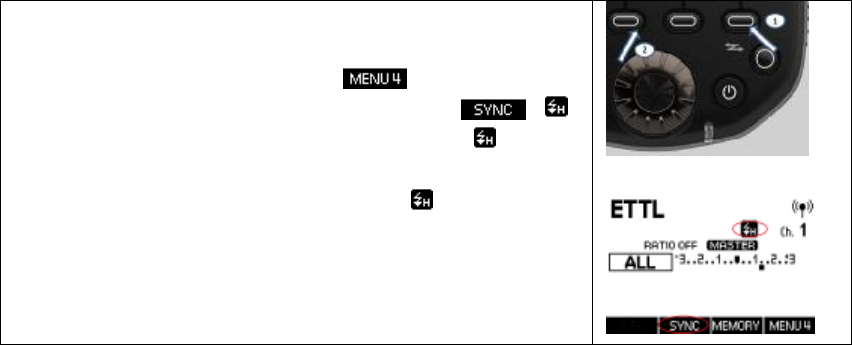
Note:
1)You can choose whether or not to cancel FEB automatically after shooting three
shots with FEB by setting C.Fn03.
2)You can change the order of FEB sequence by setting C.Fn04.
3. High-speed Sync
With the high-speed sync function, the flash can synchronize with all shutter speeds.
This is convenient when you want to use aperture-priority AE for fill-flash portraits of
a subject.
High-speed sync function is available for EOS digital cameras since 2012 only.
1. Press function button 4 until is displayed.
2. Press function button 2 corresponding to ,
will be displayed on the screen. Check if is lit in
the view finder.
3. Press function button 2 will disable .
4. FEL: FE Lock
FE (Flash Exposure) lock locks the correct flash exposure setting for any part of the
scene. Perform FE lock by operating the camera. For the operation, see the camera
and flash’s instruction manual.
5. About Master Units
You can use two or more master units (master units + slave units = maximum of 16
units). By preparing multiple cameras with master units attached, you can shoot by
changing cameras while keeping the same lighting (slave units).
Note that when using two or more master units, the color of the <LINK> lamp varies
depending on the order in which the power was turned on. The first master (main
master) is green and the second subsequent masters (sub masters) are orange.
ETTL: Wireless Multiple Flash Shooting with Flash Ratio
1. Autoflash shooting with Two Slave Groups
You can divide the slave units into two firing groups A and B, and adjust the lighting
balance (flash ratio) for shooting. The exposure is controlled automatically so that the
total flash output of firing group A and group B results in the standard exposure.
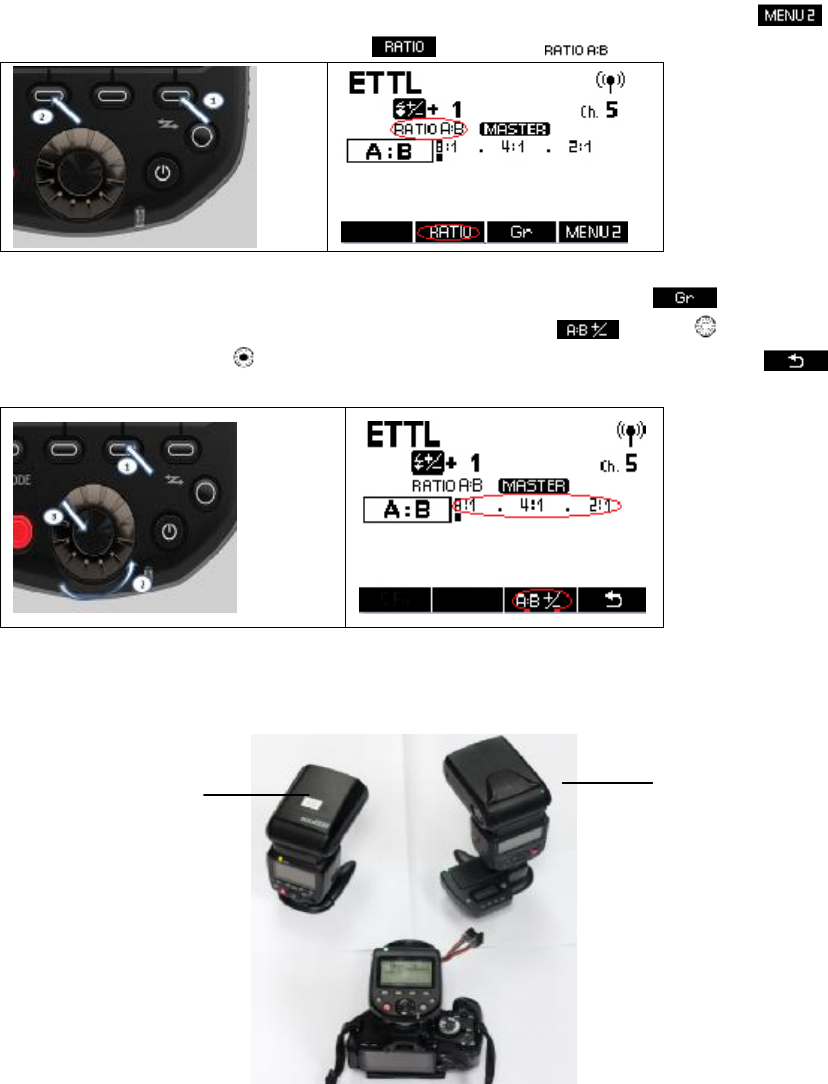
1.1 Set the firing group of the slave units
Operate and set the slave unit group one by one. Set one unit to <A>, and set the other
to <B>. For the slave unit settings, see the flash or receiver’s instruction manual.
1.2 Set the ratio mode: Press the master unit’s function button 4 to display .
Press function button corresponding to to set to < >.
1.3 Set the flash ratio: Press function button 3 corresponding to , and again
press the function button 3 while it is corresponding to , turn< >to set the
flash ratio and press< >button. Press function button 4 corresponding to
to return to shooting-ready state.
1.5 Take the picture: the slave unit flash at the set flash ratio.
2. Autoflash Shooting with Thee Slave Groups
You can add firing group C to firing groups A and B. C is convenient to set lighting so
as to eliminate the subject’s shadow. The setting method is the same as “Autoflash
Shooting with Two Slave Groups”
A B
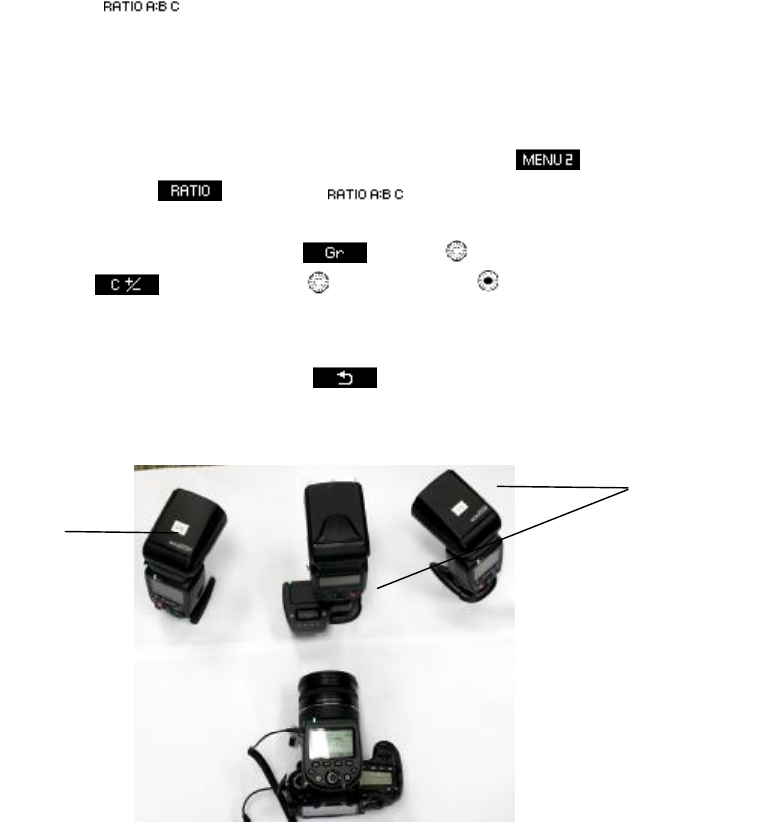
At the ratio mode , group A and B can be set by flash ratio. Group C is
independent with its flash output level assigned by the camera.
2.1 Set a flash as firing group C: For the slave unit settings, see the flash’s
instruction manual.
2.2 Press the master unit’s function button 4 to display . Press function
button 2 corresponding to to set to < >
2.3 Set flash exposure compensation as required
Press function button 3 corresponding to , turn < > and press function button
3 corresponding to . Again turn < > and press < > button to set the flash
exposure compensation amount for group C.
Press function button 4 corresponding to to return to shooting-ready state.
3. Slave Group Control
If you need more flash output or wish to perform more sophisticated lighting, you can
increase the number of slave units. Simply set an additional slave unit to the firing
group (A、B or C)whose flash output you want to increase. You can increase the
number of slave units up to 15 units in total.
For example, if you set a firing group with three slave units to A, the three units are
controlled as a single firing group A with a large flash output.
M: Wireless Multiple Flash Shooting with Manual Flash Output
When doing multiple flash shooting with manual flash output, you can shoot with a
different flash output setting for each slave unit (firing group). Set all the parameters
on the master unit.
A:B
C
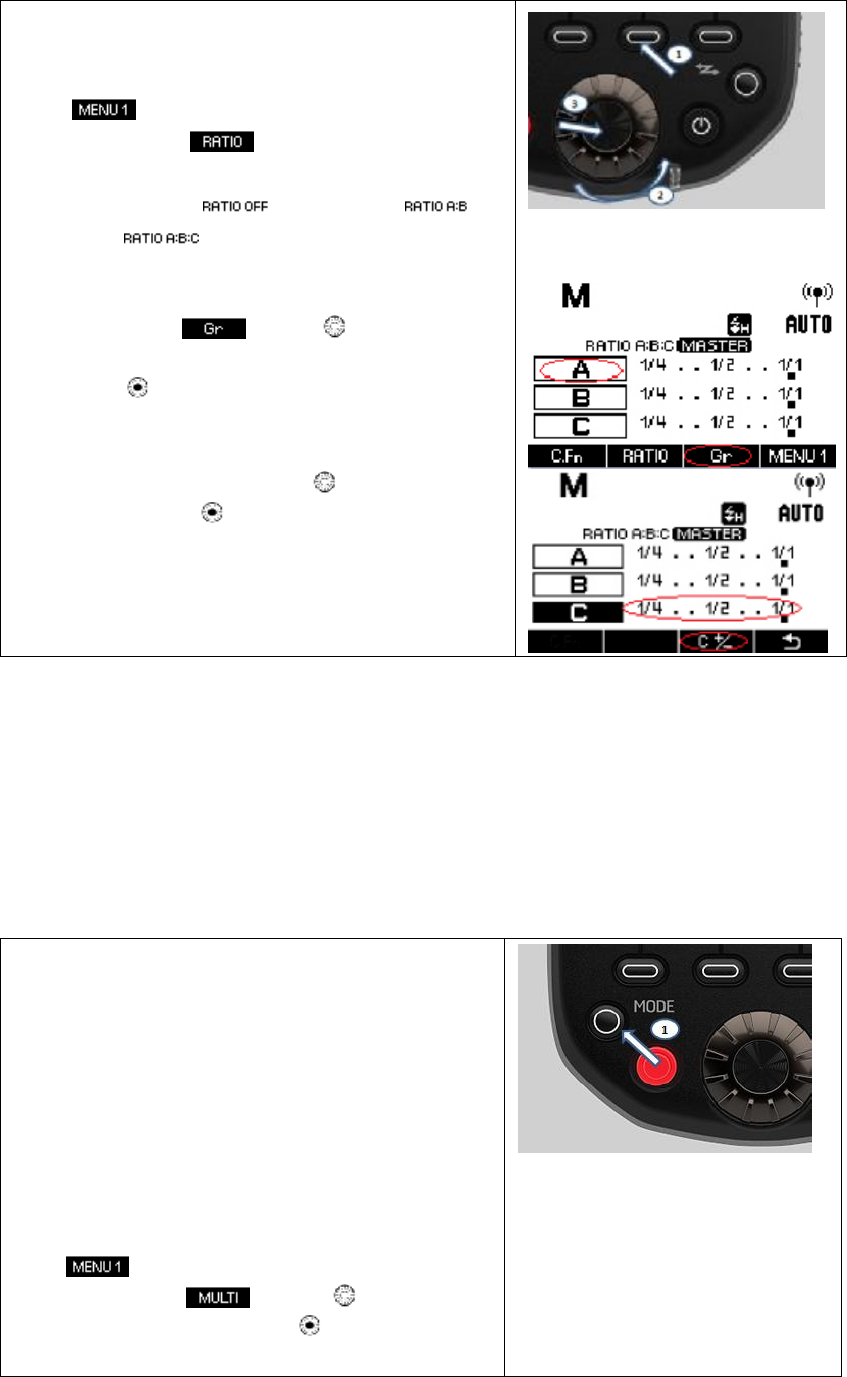
1.Press <Mode> button to set the flash mode to
<M>
2.Set the number of firing group:
While is displayed, press function button 2
corresponding to to set the groups to fire.
The setting changes as follows each time pressing
the button: ALL( )→A/B ( )
→A/B/C( ).
3.Select a firing group: Press function button 3
corresponding to , turn< > to select the
group for which you want to set the flash output,
and press < >button.
4.Set the flash output: Press function button 3
corresponding to <*±>, turn< >to set the flash
output and press < >button. Repeat step 3and 4
to set the output of all groups
5.Take the picture: each group fires at the set flash
output
MULTI: Stroboscopic Flash
Stroboscopic flash is an advanced manual flash shooting method. When using
stroboscopic flash with a slow shutter speed, you can shoot multiple successive
movements within a single picture, similar to stop-motion pictures. In stroboscopic
flash, set the flash output, number of flashes, and flash frequency (number of flashes
per second = HZ).
1. Press master unit’s <MODE>button to set the
flash mode to<MULTI>.
2. Set the number of firing groups and flash
output for each group by referring to manual flash
on the preceding page.
3. Set the flash frequency and number of
flashes:
when is displayed, press function button 2
corresponding to , turn< > to set the
number of flashes and press< >button;
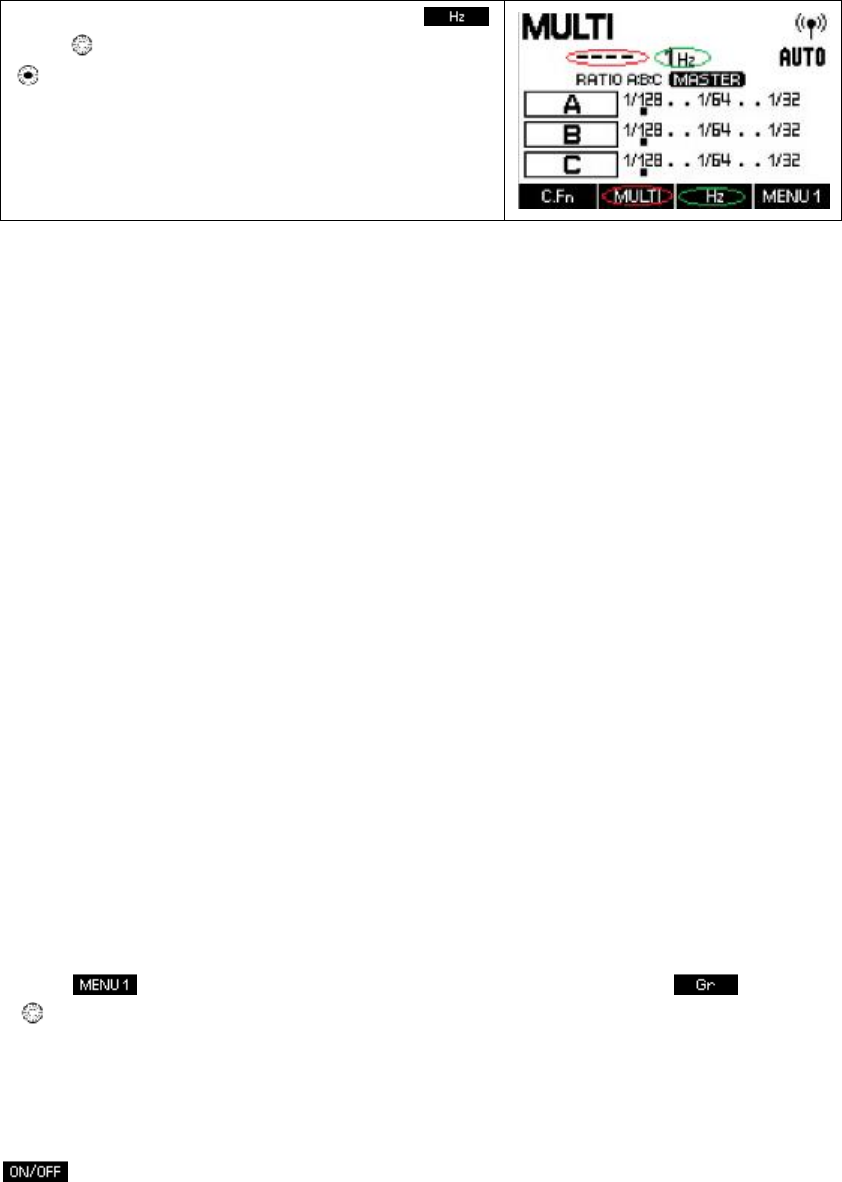
Press function button 3 corresponding to ,
turn< > to set the flash frequency and press<
>button.
Note
1. High speed sync function is not available when using stroboscopic flash.
2. E3+ receiver does not support MULTI mode. When master unit is set to MULTI
mode, the slave unit that uses E3+ receiver does not fire.
Gr: Shooting with a Different Flash Mode for Each Group
When using an EOS digital camera released since 2012, you can shoot with a
different flash mode set for each firing group, with up to 5 groups(A/B/C/D/E).
The flash modes that can be set are E①-TTLⅡ/E-TTL autoflash, ②Manual flash and
③Auto external flash metering. When the flash mode is ① or ③, exposure is
controlled to result in standard exposure for the main subject as a single group. The
function is for advanced users.
1. Set the flash mode to <Gr>
Press <MODE> button on master unit to set the flash mode to <Gr>.
2. Set the firing group on the slave units
Operate and set the slave units one by one, and set a firing group(A/B/C/D/E)for all
the slave units. For slave unit settings, see the flash or wireless receiver’s instruction
manual.
3. Set the flash mode
Set the flash mode of each firing group by operating the master unit.
While is displayed, press function button corresponding to and turn
< >to set the group.
Press function button 2 corresponding to <*Mode> to select the flash mode of the
selected group from <ETTL>, <M>and<Ext.A>.
To turn off the firing of the selected group, press function button 1 corresponding to
and set it to <OFF>.
Repeat step 3 to set the flash mode.
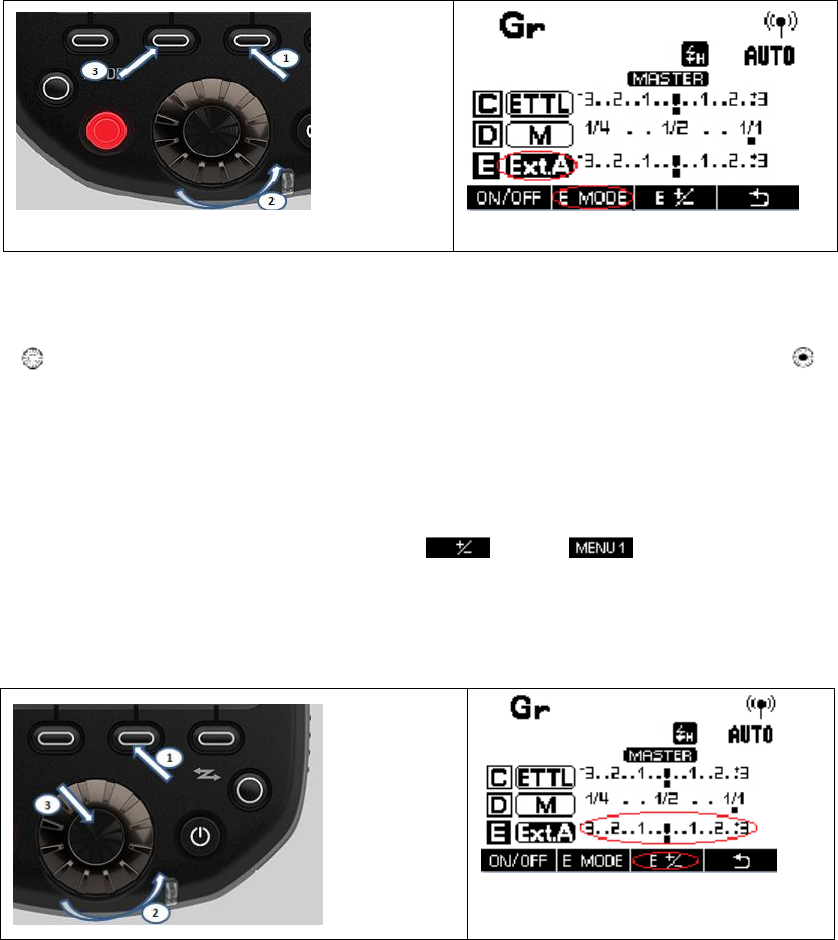
4. Set the flash output or flash exposure compensation amount
While a firing group is selected, press function button 3 corresponding to <*±>, turn
<> to set the flash function corresponding to the flash mode, and press< >
button.
When using the <M> mode, set the flash output. When using the <ETTL>or<Ext.A>,
set the flash exposure compensation amount as required.
Press function button corresponding to when is displayed, flash
exposure compensation can be set for all groups.
Repeat step 4 to set the flash function of all groups.
5. Take the picture: each slave units fires in the flash mode set for each group.
Linked Shooting
Linked shooting is a function that automatically releases the shutter of a slave unit
camera by linking it to a master unit camera. You can shoot with linked shooting for
up to 16 units, including both master units and slave units. This is convenient when
you want to shoot a subject from multiple angles at the same time.
To shoot with linked shooting, attach E3+ transmitter, and canon flash that supports
radio transmission wireless shooting or the canon ST-E3-RT Speedlite transmitter to
the camera.
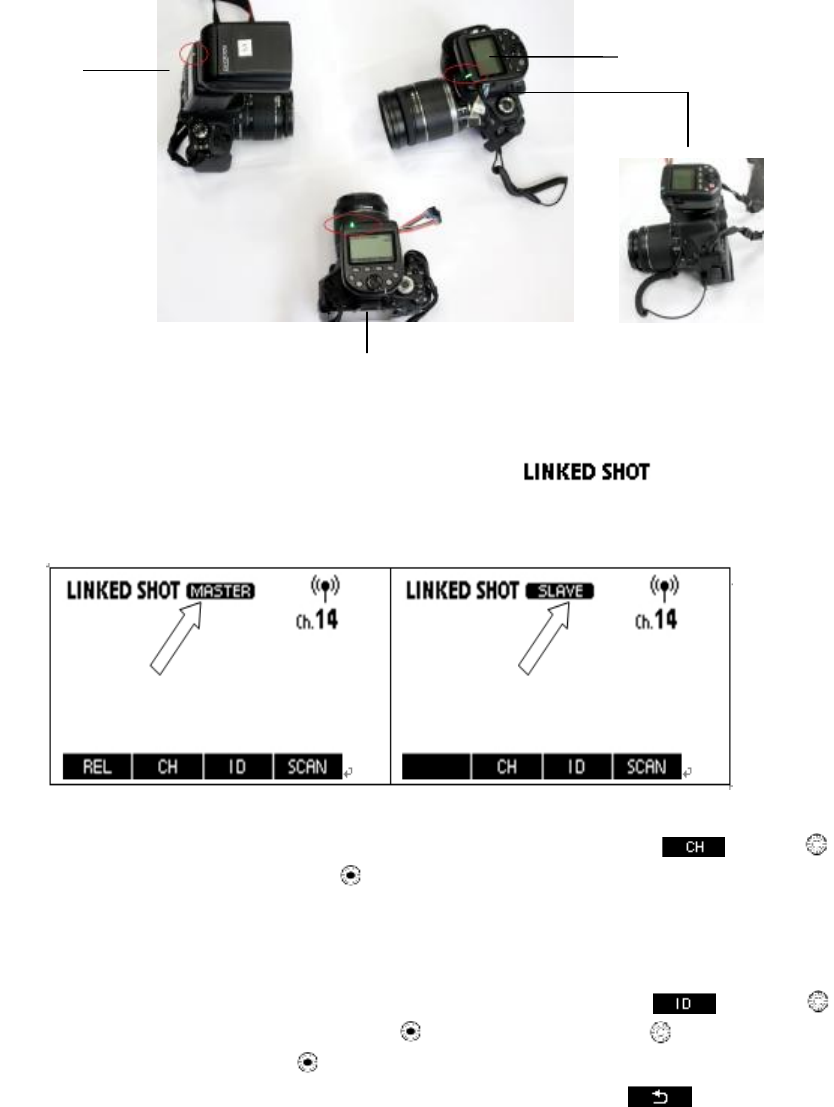
Linked shooting setting
1. Set to linked shooting mode
Press and hold linked shooting button until is displayed. Linked
shooting mode’s “Slave unit” is set; Press linked shooting button again to set
“Master unit” of linked shooting mode.
2. Set the channel and ID
Set the channel by pressing function button 2 corresponding to , turn < > to
select the channel and press < >button. You also choose to scan the radio reception
status and set the master unit’s transmission channel automatically or manually. For
operation please refer to preceding wireless setting section.
Set wireless radio ID: press function button 3 corresponding to , turn < > to
select the digit to be set, and press < > button. Again turn < > to select a number
from 0-9, and press the < > button. Repeat the procedure to set the 4 ID digits one
by one. Press function button 4 for corresponding to to return to the
shooting-ready state.
3. Set the camera’s shooting functions
4. Set all the transmitters
Repeat steps 1to3 and set all the transmitters to “Master unit” or “Slave unit” in the
Master
Slave
Slave

linked shooting mode.
Set the Speedlites used in linked shooting in the same way.
When pressing linked shooting button to change the setting of a unit from “Slave unit”
to “Master Unit”, the other transmitter (or Speedlites) that were set to “Master Unit”
until then automatically switch to “Slave unit.
5. Set up the slave unit cameras
Check that the <LINK> lamp of the slave unit lights green and place all the slave
units within master unit’s the radio transmission range.
6. Take the pictures
Check that the <LINK> lamp of the master unit lights green and take the picture. The
slave unit cameras are released in coordination with the master unit camera. After
shooting with linked shooting, the <LINK> lamp of slave unit briefly lights orange.
7. Press function button 1 corresponding to on master unit will release the
shutter of all slave unit cameras.
Noted:
1.When using the linked shooting function, the slave unit camera might need a shutter
release cable(available separately) depending on the camera models.
3) EOS digital cameras since 2012 do not need to use shutter release cable.
4) EOS cameras before 2012, which are compatible with E-TTL II/E-TTL autoflash
and come with N3 type remote terminal EOS, shutter release cable will be needed for
linked shooting.
2. Shooting with manual focus is recommended for the slave unit cameras. If focus
cannot be achieved with autofocus, linked shooting is not possible with the
corresponding slave unit cameras.
V. Setting Transmitter Functions with Camera Operations
Note: When the camera’s shooting mode is set to fully automatic mode or an Image
Zone mode, the operations below are not available. Please set the camera’s shooting
mode to P/Tv/Av/M/B(Creative Zone mode).
When using EOS digital camera released since 2007, you can set flash functions,
transmitter functions or Custom Functions from the camera’s menu screen. For the
camera operations, see the camera’s instruction manual. (Examples displayed are EOS
6D menu screen)
1. E3+ Transmitter Function Setting
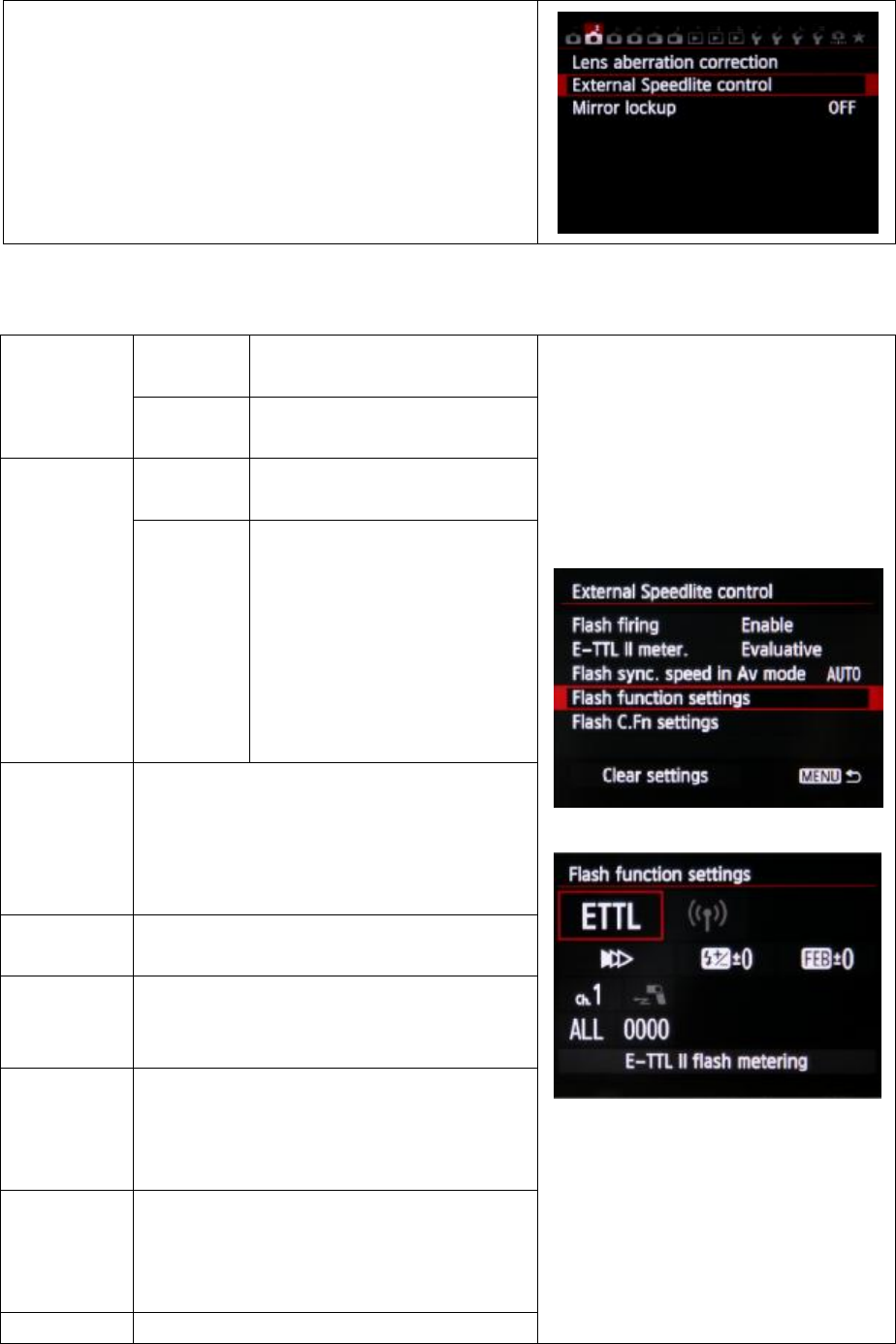
1.Select [External Speedlite control]or[Flash control].
2.Select[Flash function settings]or[External flash func.
setting], the screen changes to the(external)flash
function settings screen
3.Select an item and set the function.(The setting
screen varies depending on the camera)
2.Settings Available in [Flash function settings]
Flash firing
[Enable] Enable wireless flash
shooting
[Disable] Disable wireless flash
shooting
E-TTLⅡfl
ash
metering
[Evaluati
ve]
For normal exposures
[Average]
Flash exposure will be
averaged for the entire
scene metered by the
camera. Flash exposure
compensation may be
necessary depending on the
scene. This setting is for
advanced users.
Flash
synchroniz
ation
speed in
AV mode
You can set the flash sync speed when
performing wireless flash shooting in
aperture-priority AE(Av) mode
Flash mode
E-TTLⅡ/Manual flash/ MULTI flash
/Individual group control
Shutter
synchroniz
ation
1st curtain / High-speed synchronization
Flash
exposure
compensati
on
Users can set the exposure compensation
for flash up to ±3 stops in 1/3-stop
increments.
FEB Users can take three shots while
automatically changing the flash output,
with settable range up to ±3 stops in
1/3-stop increments.
Wireless Radio transmission wireless flash
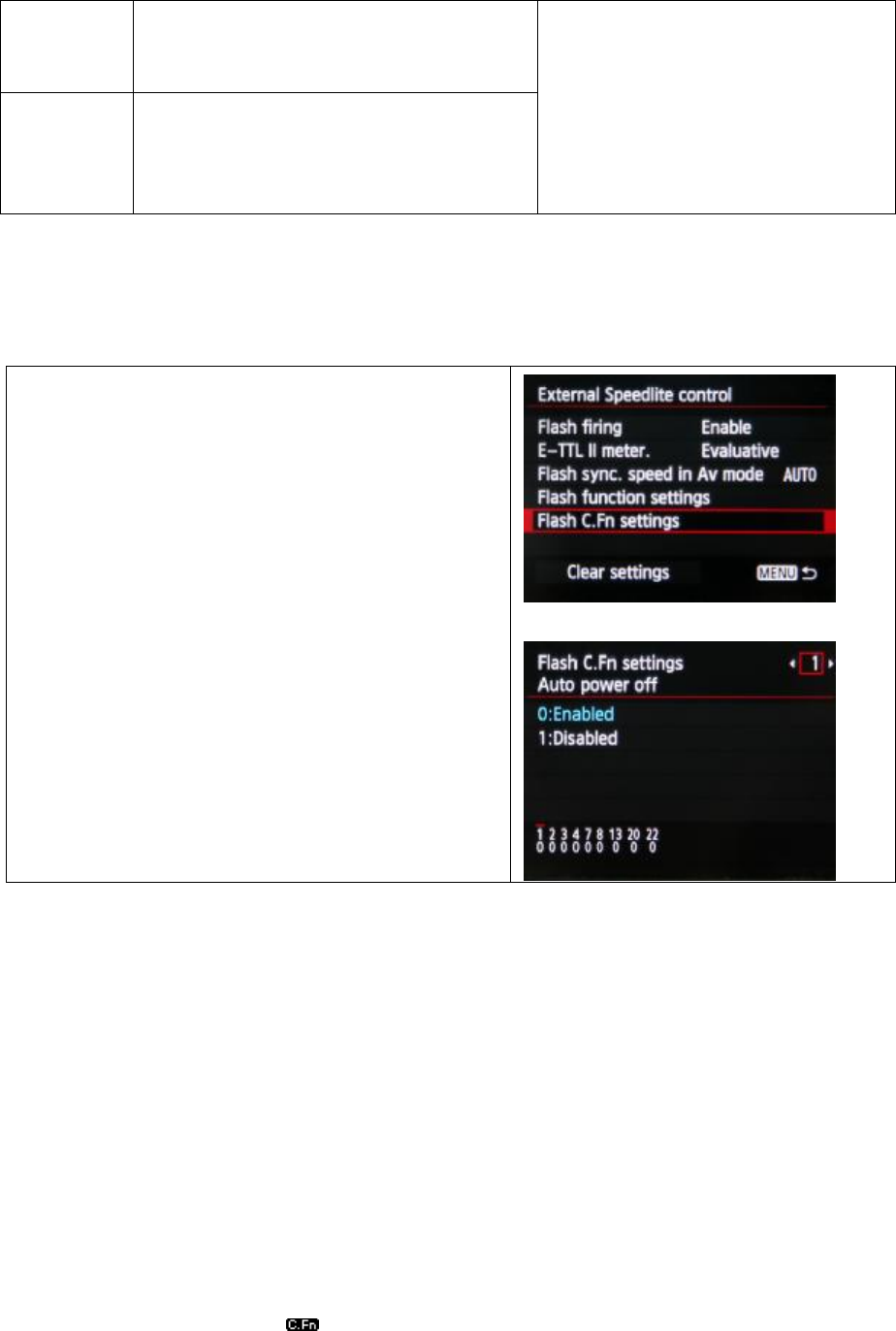
flash
functions
(setting)
shooting is set automatically.(*For EOS
digital camera released since 2012).
Clear
Speedlite
function
settings
You can restore E3
+
transmitter to their
default settings
3. Transmitter Custom Function Settings
The displayed contents vary depending on the camera. If C.Fn-20 and 22 are not
displayed, set them by operating the transmitter.
1. Select[Flash C.Fn settings]or[External flash
C.Fn setting]
2. Select the Custom Function number and set
function
3. To clear all the Custom Function settings, select
[Clear all Speedlite C.Fn’s] or [Clear ext. flash
C.Fn set] in step 1.
Note: [Auto power off] under [Flash C.Fn settings] is
corresponding to E3+transmitter’s C.Fn 01: Auto IDLE.
You can enable or disable Auto IDLE for E3+transmitter
by operating the Camera menu option.
VI. Customizing the Transmitter
E3+ Transmitter supports Custom function(C.Fn)and Personal Function(P.Fn)setting.
You can customize the transmitter features to suit your shooting preferences with
custom functions and personal functions. Note that the personal functions are
customizable functions unique to the E3+ transmitter.
Note: When the camera’s shooting mode is set to fully automatic mode or an Image
Zone mode, the operations below are not available. Please set the camera’s shooting
mode to P/Tv/Av/M/B(Creative Zone mode.
1. C.Fn: Setting custom functions
1.Press function button 4 until is displayed on the screen.
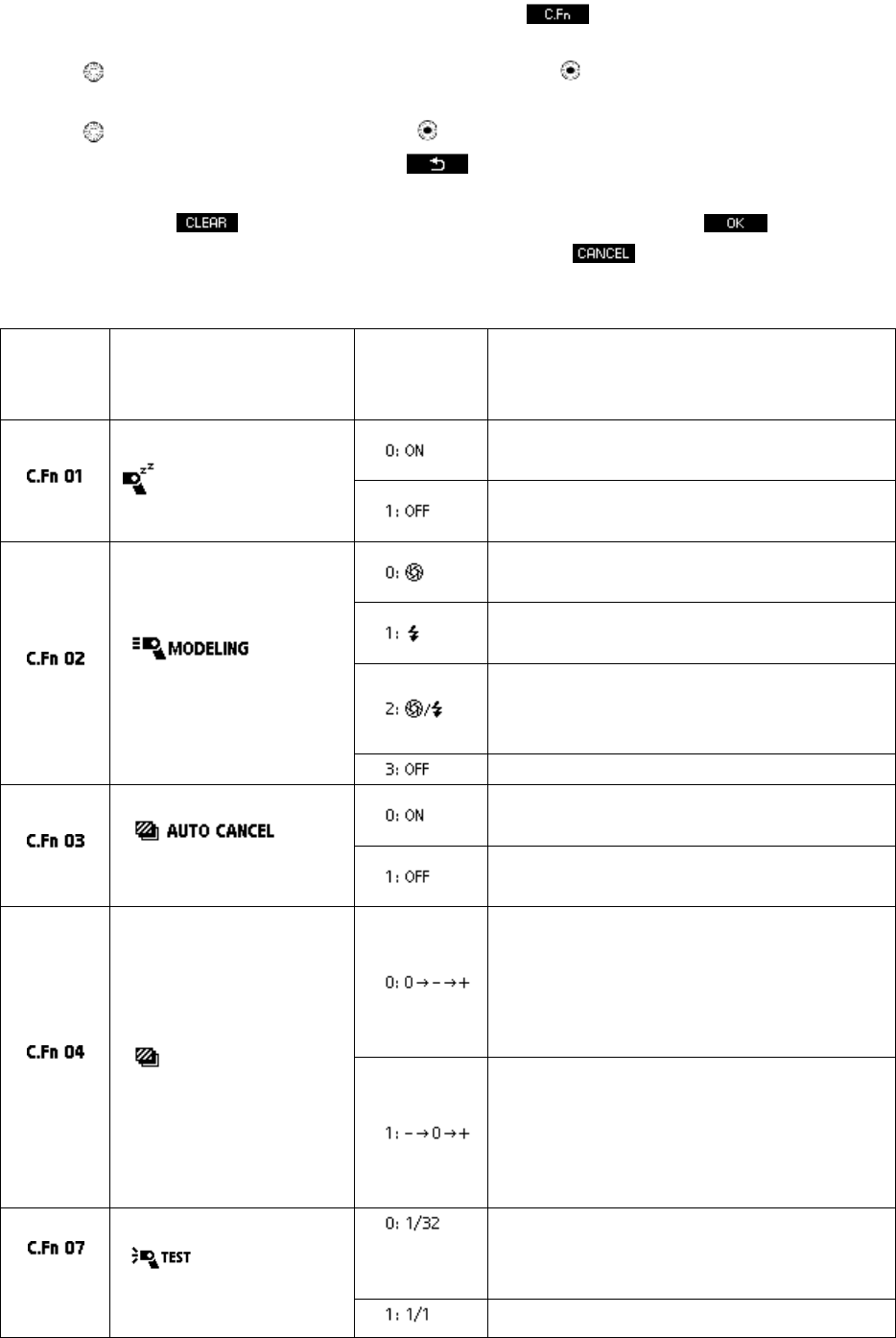
2.Press and hold the function button 1 corresponding to until Custom Function
screen is displayed.
3.Turn< >to select an item(number) to set, and press< >button to display the
setting.
4.Turn< >to select the setting, and press< > button to confirm the selection
5.Press function button 4 corresponding to to return to previous state.
6.To restore all the default settings of custom function, press function button 2
corresponding to , and press function button 1 corresponding to .To
cancel the operation, press function button 4 corresponding to .
Custom Functions Chart
Custom
Function
No.
Functions Setting No.
Setting and descriptions
: Auto IDLE
Enable Auto IDLE when the E3
+
transmitter is not operated for 5min.,
Disable Auto IDLE when the E3
+
transmitter is not operated for 5min.,
:
Modeling flash
Press the camera’s depth-of-field preview
button to fire the modeling flash
Press E3
+
transmitter’s test flash button to
fire the modeling flash
Press the camera’s depth-of-field preview
button or E3+ transmitter’s test flash
button to fire the modeling flash
Disable the modeling flash
: FEB
auto cancel
Enable: Set to automatically cancel FEB
after shooting three shots with FEB
Disable: Set not to automatically cancel
FEB after shooting three shots with FEB
: FEB sequence
Set the order of FEB sequence as
following:
0: Standard exposure
- : Decreased exposure(darker)
+ : Increased exposure(brighter)
Set the order of FEB sequence as
following:
- : Decreased exposure(darker)
0: Standard exposure
+ : Increased exposure(brighter)
: Test firing with
autoflash
Set the flash output as 1/32 when firing
the test flash in E-TTLⅡ/E-TTL
autoflash
Set the flash output as 1/1 when firing the
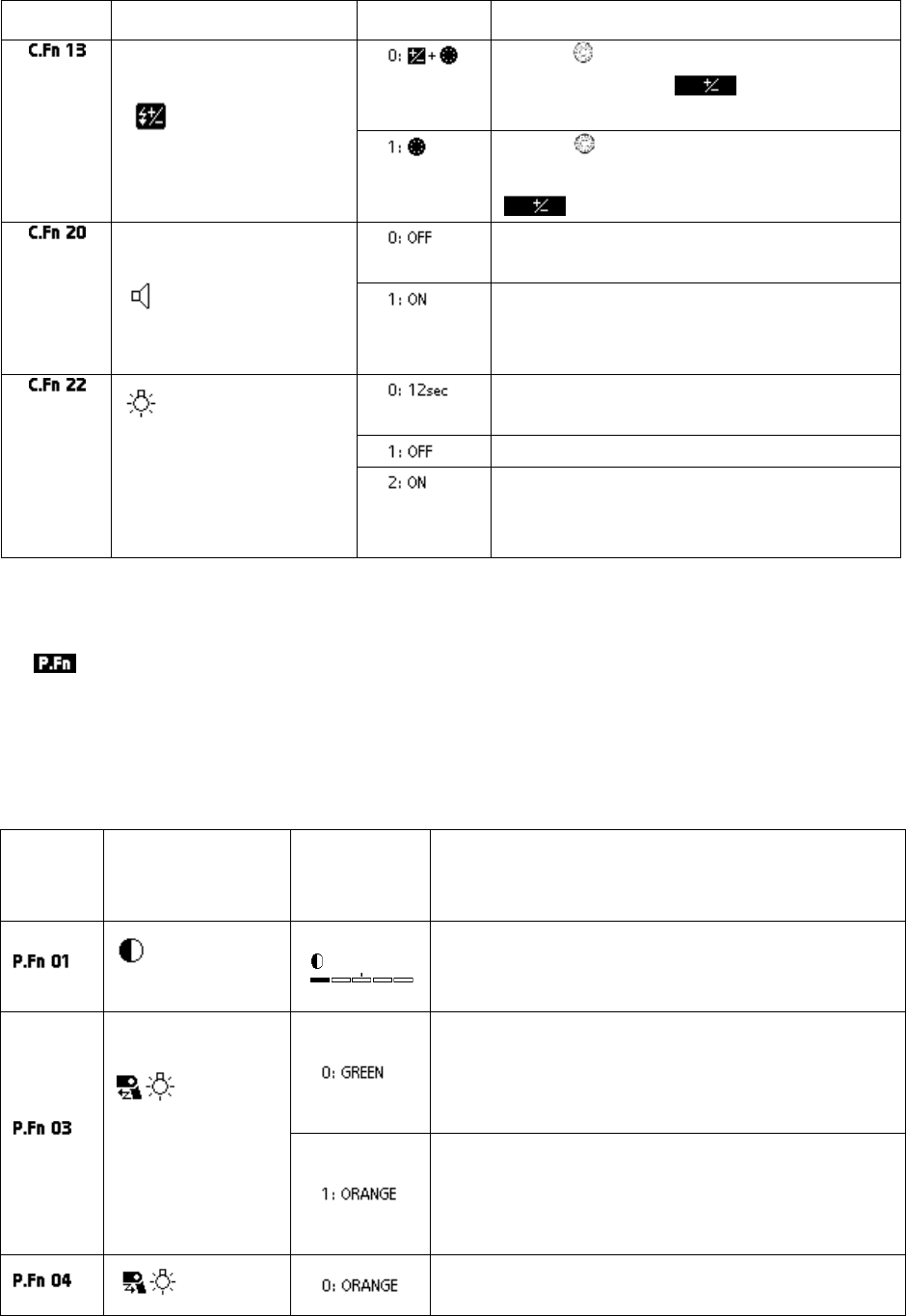
test flash in E-TTLⅡ/E-TTL autoflash
: Flash exposure
metering setting
Turn< >and press button function
corresponding to to perform flash
exposure compensation
Turn< >directly to perform flash
exposure compensation without pressing
button.
: Beep
Disable beep to sound on E3
+
transmitter
when the slave unit is fully charged
Enable a beep to sound on E3
+
transmitter when the slave unit is fully
charged
: LCD panel
illumination
When a button or dial is operated, the
LCD panel illumination go on for 12 sec.
Disable LCD panel illumination
When a button or dial is operated, the
LCD panel illuminates and keeps always
on.
2. P.Fn: Setting personal functions
1. When Custom Function screen is displayed, press function button 1 corresponding
to to display Personal Function screen.
2. Set the personal function in the same way as step 3 and 4 for the custom function.
3. To restore all the default setting of personal function, set it in the same way as step
6 for custom function.
Personal Functions Chart
Personal
Function
No.
Functions Setting No.
Setting and descriptions
: LCD panel
display contrast
You can adjust the contrast of the LCD panel in
5 levels.
:LCD
panel
illumination
color: Master
When the E3
+
transmitter is set as master unit
(radio transmission wireless shooting, linked
shooting), select green as color of the LCD
panel illumination.
When the E3
+
transmitter is set as master unit
(radio transmission wireless shooting, linked
shooting), select orange as color of the LCD
panel illumination.
:LCD When the E3
+
transmitter is set as slave unit
(linked shooting), select orange as color of the

panel
illumination
color: Slave
LCD panel illumination.
When the E3
+
transmitter is set as slave unit
(linked shooting), select green as color of the
LCD panel illumination.
: AF assist
beam
Enable the AF assist beam
Disable the AF assist beam
VII. Trouble Shooting Guide
1. Power does not turn on
1.1 Make sure the batteries are installed in correct orientation.
1.2 Check battery contacts are in good contact and that the batteries are sufficient
with power.
2.The Slave unit doesn’t fire
2.1 Check if the slave unit supports radio transmission wireless flash
2.2 Set the slave unit to < >< >.
2.3 Set the transmission channels and wireless radio IDs of the master unit and slave
unit to the same numbers.
2.4 Check if the slave unit is within the transmission range of the master unit.
2.5 If using E3+receiver, please refer to the receiver’s manual instruction to check the
operation.
3. < >is displayed
Set the shutter speed 1 stop slower than the flash sync speed.
VIII.Technical Specification
Type On-camera wireless flash trigger
Compatible cameras EOS type-A camera compatible with E-TTL II/E-TTL autoflash
Exposure control
system
E-TTLⅡ/E-TTL auto, manual flash, stroboscopic flash, auto
external flash metering(only when the flash mode is set to
<Gr>).
Frequency 2405 – 2475Hz
Modulation system Primary modulation: OQPSK, secondary modulation: DS-SS
Channel Auto, Ch.1-15
Wireless radio ID 0000-9999
Slave unit control Up to 5 groups(A/B/C/D/E), up to 15 units
Transmission distance 100m+
Flash ratio control 1:8-1:1-8:1, 1/2-stop increments

Flash exposure
compensation
±3 stops in 1/3- or 1/2- stop increments
FEB ±3 stops in 1/3- or 1/2- stop increments(when used with flash
exposure compensation)
FE lock Press the camera’s<M-Fn>、<FEL>or<*>button
HSS function Provided, high speed sync is possible only with EOS digital
cameras released since 2012
Manual flash 1/1-1/128(1/3-stop increments)
Stroboscopic flash Provided( 1 - 500 Hz)
Slave battery check On the master unit’s LCD panel, the < >icon lights, the slave
unit’s AF assist beam emitter blinks and charge the lamp lights
Flash exposure
confirmation
Flash exposure confirmation lamp lights
Modeling flash Fired with camera’s depth-of-field preview button
Linked Shooting Provided
Custom functions 8
Personal functions 4
AF assist light
Peak wavelength 650nm
Optical power <5mW
Spot diameter at
1m
Injecting distance 1m: L-335mm W-326mm
(angle of the sector at approx.20º)
Operating
temperature
-10℃~+40℃
Power source 2 x AA alkaline batteries or AA NI-MH batteries
Power saving Auto Idle if not operated for 5 min.
Standby current 70mA
Static current ≤250uA
Dimension (L×W×H):(84.1×68.3×58.5)mm
Weight(approx.) 118 g(Excluding the batteries)
Please note: Product specifications and external design are subject to change without
further notice.